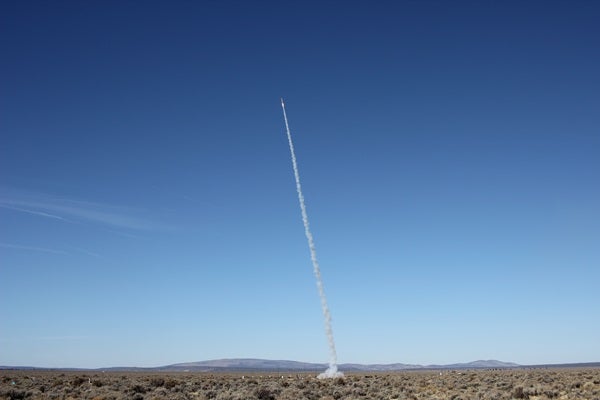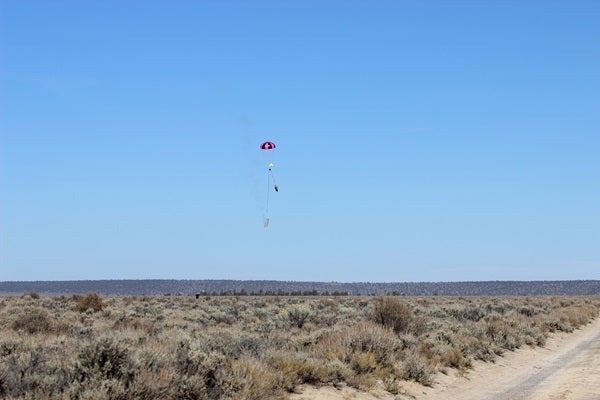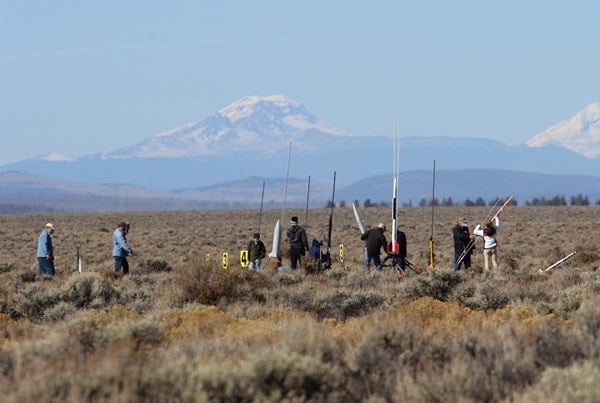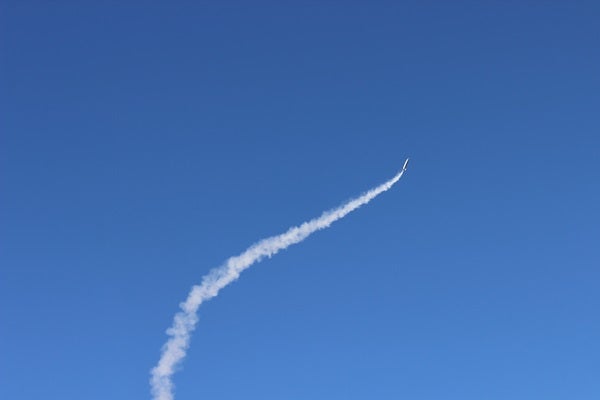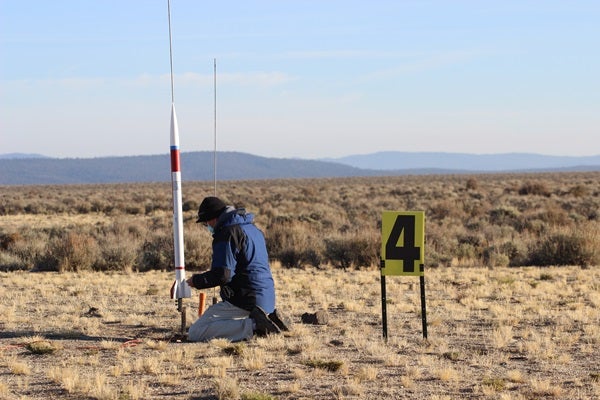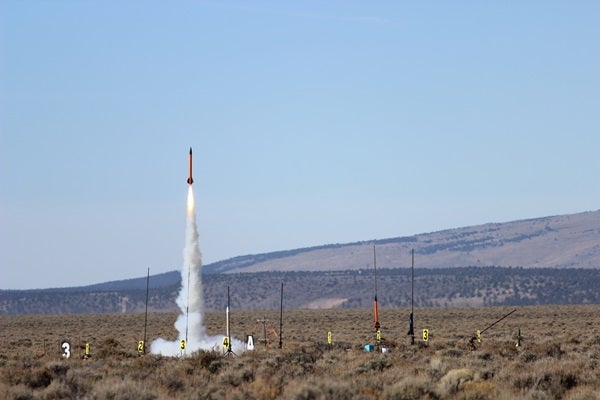Brothers is a place that has somehow slipped outside the passage of time. Located in a sea of sagebrush in central Oregon, this former stagecoach stopover once serviced horse-drawn migrants bound for the Willamette Valley. When cars replaced carriages, the town transitioned to a highway fill station, one of few in this arid and isolated expanse. But even that business has faded through the years, and the pumps of the historic Brothers Stage Stop now stand empty.
A clutch of attractive prefab homes with nearby sheds, scrub pines, and satellite-dishes indicate some kind of human presence, and a red and white schoolhouse is freshly painted. But the only other signs of civilization are the four pit toilets and picnic tables of the Brothers Oasis, a rest stop maintained by the Oregon Department of Transportation. The view from the picnic tables is the same as from anywhere in Brothers: sage, rabbitbrush, greasewood, and cheatgrass to the horizon.
But you can turn southwest on the right afternoon for a surprise: the unmistakable snarl of rockets erupting from the steppe follows smoke trails across the sky.
Thanks to the nonprofit organization OregonRocketry, Brothers has outlasted the surrounding ghost towns to find new purpose as one of the preeminent high-power rocket launch sites in America. The group has purchased land and established a site out here in coyote country for the advancement of amateur rocketry and education of future aerospace engineers. They have a waiver from the FAA that currently allows them to blast the things nearly four miles into the air any afternoon they please, and they are allowed launches to 50,000 feet (15,240 m) above ground level with approval.
There are few places in the United States where amateur rocketeers can regularly reach such altitudes.
“We get those high waivers because we’re so remote; how high we can fly is dependent on our proximity to things like highways and occupied buildings,” explains Robert Braibish, the treasurer of OregonRocketry. “The groups flying from Black Rock Desert [in Nevada] have unlimited elevation — they can launch into space. But not many launch sites can get up to 50,000 feet like we do here.”
An unusually high waiver isn’t the only thing distinguishing the Brothers site from others around the nation; the landscape itself challenges rocketeers in a way other sites don’t. Though popular imagination focuses on the fiery drama of launch and the elegance of ascent, rocketeers are equally concerned with what happens to a rocket once it reaches apogee — the point of maximum height above Earth.
If all goes to plan, gunpowder charges split the rocket’s nose from its base soon after it begins descent, releasing a parachute or series of parachutes. The rocket slows first to 50 then 25 feet per second, gyrating across the blue before crumpling into the sage. That’s when the fun begins.
“Our site on a map looks kind of flat, but in reality, it’s not,” says Jack Caynon, who’s flown at Brothers since 2005. “There’s lots of divots and small hills, so when you look over the distance, you think your rocket’s in that flat area over there when actually it’s in a crevasse. Sighting along the sagebrush is difficult, because there’s a thousand of them and one looks just like another.
“The easy way to search is to use some kind of onboard tracker — I have a radio tracker, and just by sweeping the antenna, I can pinpoint the direction of the rocket. It takes me 10 or 20 minutes maybe to get to the rocket, but I find it without fail.”
But all doesn’t always go according to plan, and not all club members recover their rockets as easily as Mr. Caynon. Over the course of a windy October day spent observing launches last year, I saw half a dozen rocketeers return to camp empty-handed, kicking up dust, cursing the sage and faulty transmitters. I witnessed at least a dozen more carrying crippled rockets; parachutes didn’t deploy in time or at all, and months of hard work resulted in crash landings on high-desert hardpan, rendering the rockets useless for future flights.
OregonRocketry members were already fanned out among the sagebrush, antennae and GPS receivers held high, when my wife and I arrived to Rocketober 2021. This was the club’s largest launch of the year, and with the site shut down all summer due to drought-induced fire hazard, members were eager to fly.
I had never been to a rocket launch before and anticipated something similar to an especially technical fireworks show. But this was no fireworks show. Here was something far more visceral.
The Brothers site has five launch areas, or cells: one each for low- and mid-power rockets with five launchpads a piece, roughly 40 yards from the tailgate line of tents and trailers and RVs; two for high-power rockets, with another five pads each, another 20 yards out; and the last for the largest rockets allowed at the site, 300 yards behind the line of people, elevated above the crowd on the crest of a nearby butte.
Rocket motors are categorized with a letter according to their total energy. “Each designation doubles the total energy of the previous one, so that a B is twice as powerful as an A and C twice as powerful as B,” Braibish explains. Most model rockets — the kind you can buy at hobby stores — run from Class A through E. High-power motors start at Class H, and federal regulations require a special certification to purchase them. Members of OregonRocketry regularly launch O-class rockets at Brothers, and though I didn’t witness any of those the day we attended, the handful of M and N class launches I did witness touched off a sickly mingle of awe and terror in my gut.
“We like to treat these things like weapons,” Braibish says. As well they should.
Countdowns were quick and staccato, like drumrolls over the loudspeaker, punctuated by the trumpet screech of launch. Again and again, 200 pairs of eyes followed smoke trails into the sun, just able to catch the puff of gunpowder and flash of parachute that signaled a successful flight before returning to level to witness yet another fiery launch. I couldn’t help but recall the opening lines of Thomas Pynchon’s Gravity’s Rainbow: “A screaming comes across the sky. It has happened before, but there is nothing to compare it to now.”
No, nothing in my experience to compare this to, this outrageous exhibition of propulsion and amateur ingenuity in the middle of an otherwise desolate landscape.
Braibish, who was serving as Launch Control Officer (LCO), informed us soon after arrival that there would be a two-hour midmorning break so a National Guard Air Wing unit could perform exercises.
Such interruptions aren’t uncommon here. “Brothers is a nice double-edged sword,” Braibish says. “We have another level of coordination with the Air Wing, but because this is an established training site for them, commercial air traffic isn’t much of an issue.”
Members used this military-enforced intermission to register a dizzying variety of rockets with the Range Safety Officer (RSO), who was the resident subject matter expert on rocket construction and site conditions. Each registration required a conference, and some rocketeers left theirs slump-shouldered and frowning.
“The RSO is able to look at a rocket and ask: Have you connected all the parts? How is the motor built? How did you attach these fins? Is this the first flight? They ask all the questions that are relevant to ensuring a safe flight, which is obviously our highest priority,” Braibish says. “The RSO will also look at a launch and establish certain parameters, like which cell to launch from or whether this rocket requires more attention.”
Steady winds blew from the south both days of Rocketober, and one of the prevailing safety concerns involved weathercocking.
Weathercocking is an unwanted phenomenon that rocketeers try — and sometimes manage — to mitigate. A rocket’s fins stabilize its trajectory once in flight, but under the wrong conditions, they can divert the intended direction of launch. Wind currents blowing at ground level can catch fins at the moment of ignition, tilting the rocket’s nose windward as it takes off.
If higher altitude currents blow at the same rate as those on the ground, the rocket tends to correct course once in flight, and the same fins that proved so problematic moments before now guide the rocket skyward. But if high-altitude winds are weaker than at ground level, the rocket continues on its weathercocked trajectory, blasting off in occasionally nerve-wracking deviations from plumb.
But the real danger this Rocketober, lurking somewhere between the thirsty sage and solid rocket fuel and gunpowder charges, was fire. This part of Oregon, like most of the West, has been under intensifying drought for two decades, and it’s starting to show.
“Fire has become the number one concern out here over the past five years. We’ve been here 20 years or so, and even five years ago we launched throughout the summer no problem,” says Gary Goncher, president of OregonRocketry. “But we don’t launch in July, August, or September anymore.”
The club is proactive about fire safety; they keep both a water-truck and several dozen extinguishers nearby during launches. Equipment is maintained and stored by the local Rangeland Fire Protection Association (RFPA), a volunteer group that works with federal agencies to suppress and respond to wildfires.
“We’ve become very active in our local RFPA. About twenty rocketeers are actually members now, and I think we outnumber the locals,” Goncher says.
Goncher served as Range Safety Officer the second day of Rocketober, and he had his hands full. Because Brothers is one of the country’s premier sites for high-power rocketry, college students from across the Northwest flock here to get certified with the National Association of Rocketry before competing in the annual Spaceport America Cup in New Mexico. They come in fresh-faced droves, draped in school colors and determined to push the boundaries.
“Sometimes students want to be so spectacular, and to do things off the wall, but they don’t need to. There’s ways of building rockets that are safe and can achieve the altitudes they’re wanting in the Cup,” Caynon explains. “But the Blue Origin and SpaceX people do show up to a banquet [after the Spaceport America Cup] and talk over the projects with these kids, and they’re looking for people who can think outside of the box and solve problems on the fly.”
The litany of names rang from every tongue, no matter who I talked with: Blue Origin, Bezos, SpaceX, Musk. They had a talismanic quality out there on the sage steppe, with little else to punctuate the wind except rattlesnake warnings and the roar of rockets. They seemed like invocations against drought.
“As a society, we’re starting to get to a point where rocketry seems the next step,” Braibish says. “You see where things are going with SpaceX and Blue Origin; there is obviously going to be an increase in demand for that kind of engineering and that type of student, and we try to encourage STEM education. This level of rocketry is becoming more prevalent in the public eye.”
Amateur rocketry in America’s high desert is a dual expression of our mystic past and technological, heat-ridden future.
These devotees of propulsion gather in patches of bare sand to recite obscure catechisms with their RSO and LCO, the high priests of the range. Tribute confirmed, the rocketeers carefully follow the rites of launch before experiencing the ecstasy of apogee and the agony of recovery. Hearts quicken as eyes turn skyward, hands ubiquitously raised to brows, warding off midday desert light. Parachutes deployed, rocketeers wander the withered sage with errant sunspots still swirling in their eyes, antennae aloft, praying off snakes and metering water like some ascetic medieval order.
But rocketeers also anticipate a quickly arriving future where particularly industrious or ingenious citizens can indulge the wildest dreams of the early Space Age. Advances in computing, drone technology, and artificial intelligence already suggest Jetsons-style convenience for those who can afford it. But amateur high-power rocketry evokes another vision of the future, where people have the knowledge and means to perform empirical measurements of their own environment for their own purposes.
“Maybe college students have come up with a CanSat” — a miniature satellite-style payload that can fit in a Coke can — “and they just need someone to fly it for them,” Caynon says. “Our guys would be happy to do that, and I think both students and rocketeers would learn something.”
Though some of the young scientists getting certified at Rocketober may go on to colonize Mars for Musk or build space casinos for Bezos, most won’t. That doesn’t mean they can’t use their knowledge of rocket science for the betterment of humankind. Earth’s climate and ecosystems are changing at a rate unprecedented in human history, and scientists rely on technologies like sounding rockets and research satellites to measure that change. Students who remain focused on our home planet can use rockets and small satellites to remotely measure its atmosphere and resources with a precision and ease previously unfeasible for any but the largest organizations.
That capability will become increasingly valuable as more regions of a warming world come to resemble the tinderbox topography around Brothers.
“We can launch several types of packages for scientific purposes on our rockets, like how to measure the ozone or monitor sunspot activity, and we can run the same types of sounding rocket experiments as NASA did, in probably smaller packages than they had back then,” says Caynon. “We can actually conduct science for people.”
Lucas Martin is a freelance journalist with degrees in Geographic Information Systems, Literature, and Liberal Arts. His wife Ingrid and he are advocates for the preservation and wise use of America’s high desert, and have inventoried three prospective wilderness sites with the Oregon Natural Desert Association. Starting in February 2022, he will be a Food and Entertainment reporter for The Register-Guard in Eugene, Ore.

